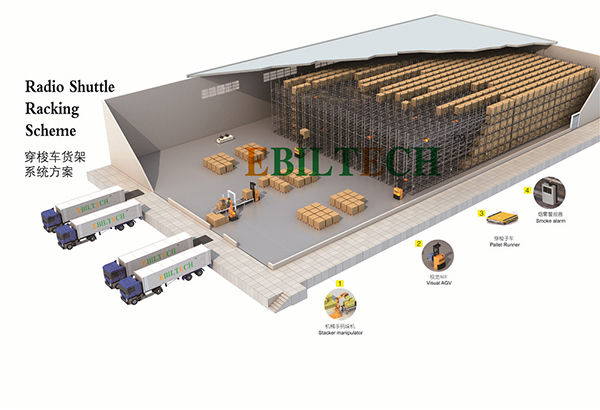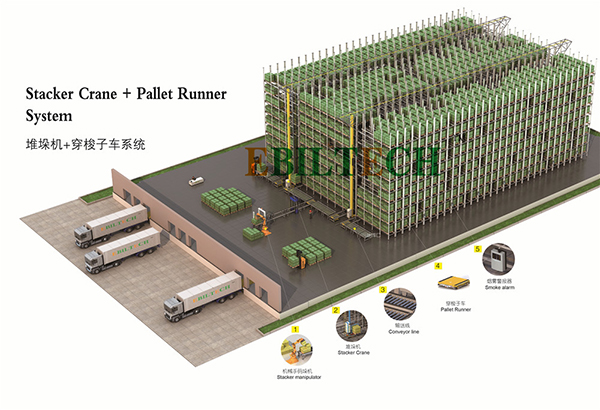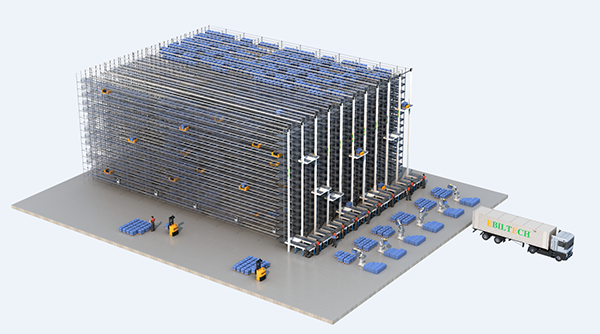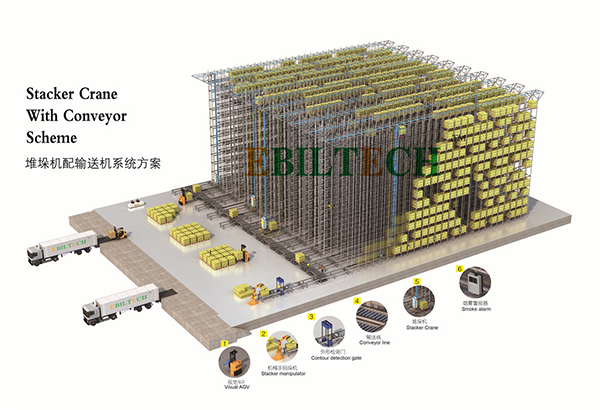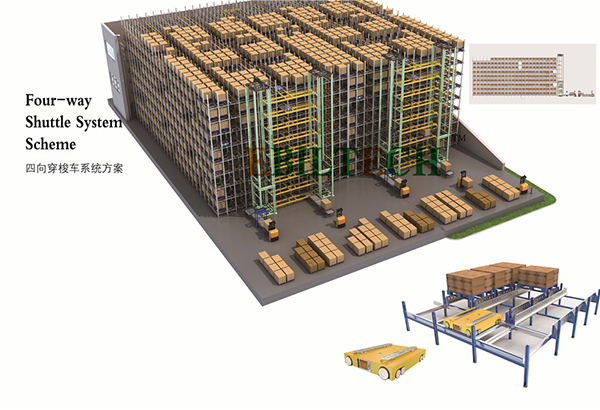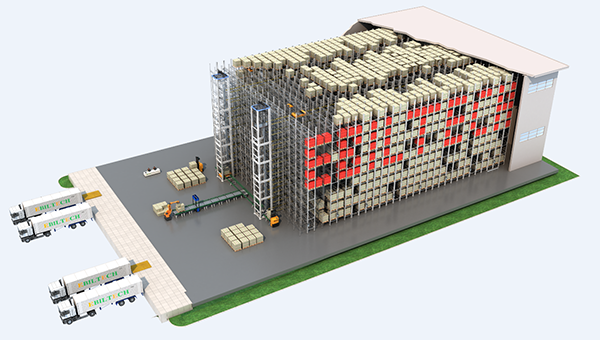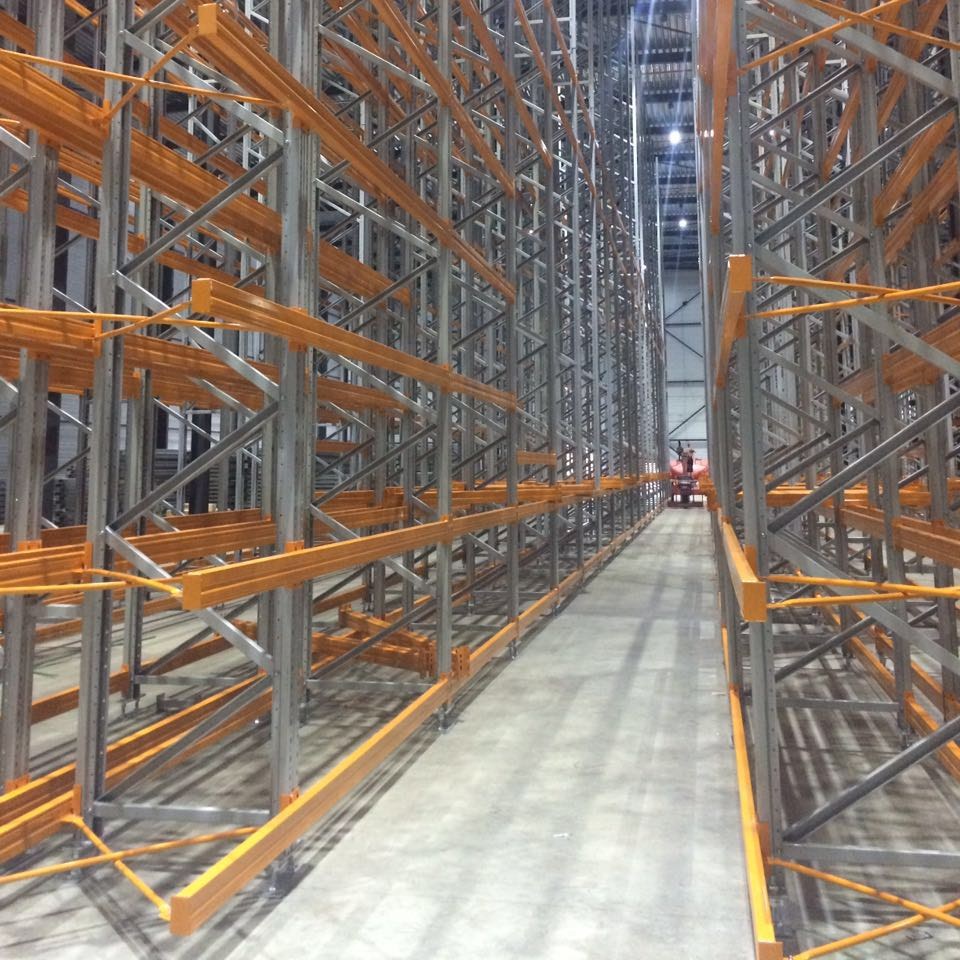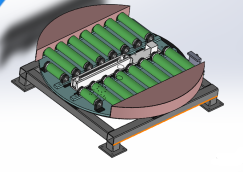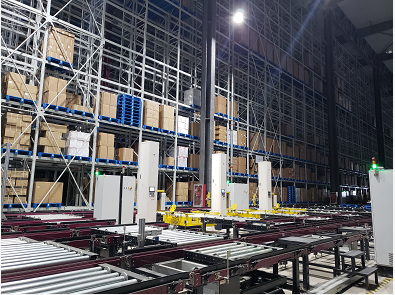Products
Ebil Tech
ASRS
ASRS is one of our products, we can provide one-stop storage system solutions and products, our products also include Standard Pallet Racking, Telescopic Arm Storage Rack, Powered telescopic arm rack, Multi-Lever Mezzanine Rack, Powered Telescopic Arm Rack, Mezzanine Floors, Gravity Pallet Racking System, Racking Beam, and so on. EBILTECH providing the automated and intelligent products of logistics system, such as pallet shuttle, stacker crane, cargo elevator, automatic transport system, other electrical automation and software of the logistics system. We have many main markets in the world, such as Ciudad Juarez (Mexico), Skopje (North Macedonia), Tunisia, Colombo (Sri Lanka), Northern Cyprus, Badme, and so on. We are looking forward to cooperate with you. If you are interested in ASRS.
AS/RS stands for Automated Storage and Retrieval System. It is a highly automated warehouse system that uses computer-controlled equipment to handle the storage and retrieval of goods, typically in palletized or unit load form. AS/RS systems are designed to optimize space utilization, improve inventory control, and enhance operational efficiency. The key components of an AS/RS typically include: Racking Structure; Storage and Retrieval Machines; Conveyor Systems; Control System. AS/RS systems are commonly used in industries with high-volume storage and retrieval requirements, such as manufacturing, distribution centers, e-commerce, and logistics. They offer a scalable and flexible solution for managing inventory, optimizing space, and streamlining warehouse operations.
Components of an AS/RS
An Automated Storage and Retrieval System (AS/RS) consists of several key components that work together to automate the storage and retrieval of goods within a warehouse. The specific components may vary depending on the system's design and configuration, but here are the common components found in an AS/RS:
1. Racking Structure: The racking structure forms the framework for storing and organizing goods. It consists of vertical frames or columns, horizontal beams, and shelves or pallet supports. The racking structure is designed to accommodate pallets, totes, or other storage units.
2. Storage and Retrieval Machines: These automated machines are responsible for handling the movement of goods within the AS/RS. They can vary in form depending on the system design and can include:
a. Stacker Cranes: Stacker cranes are vertical lifting devices that travel along the aisles of the racking structure. They can move horizontally and vertically to access specific storage locations, retrieve or store pallets, and transport them to designated areas.
b. Robotic Systems: Robotic systems, such as robotic arms or gantry robots, are used to automate the storage and retrieval processes. They can handle a variety of tasks, including picking, placing, and transferring goods between storage locations and conveyor systems.
c. Automated Guided Vehicles (AGVs): AGVs are autonomous vehicles that navigate predefined paths within the AS/RS. They can transport pallets or storage units between different zones, such as loading/unloading areas, storage locations, and picking stations.
3. Conveyor Systems: Conveyor systems are used to transport goods within the AS/RS. They connect different areas of the warehouse, such as the loading/unloading zone, storage locations, and picking stations. Conveyor systems facilitate the seamless flow of goods, enabling efficient storage and retrieval processes.
4. Control System: The control system is the central component that manages and coordinates the operations of the AS/RS. It consists of software and hardware components that control the movement of storage and retrieval machines, monitor inventory levels, optimize storage space utilization, and ensure the overall system operates smoothly. The control system may include elements such as:
a. Warehouse Management System (WMS): The WMS is software that oversees the operations of the AS/RS. It manages inventory, tracks goods, optimizes storage locations, generates picking instructions, and provides real-time data and reporting.
b. Programmable Logic Controllers (PLCs): PLCs are hardware devices that control and monitor the various automated components within the AS/RS. They receive commands from the WMS or other control interfaces and send signals to the machines and conveyors to execute specific tasks.
c. Sensors and Scanners: Sensors, such as proximity sensors or barcode scanners, are used to detect the presence of goods, monitor inventory levels, and ensure accurate positioning of storage units within the AS/RS.
5. Input/Output Stations: These are designated areas where goods enter or exit the AS/RS system. Input stations are typically located near the receiving area and are used for loading goods into the system, while output stations are positioned near the shipping area and are used for unloading goods from the system.
6. Load Carriers: Load carriers are the units that hold and transport goods within the AS/RS. They can be pallets, totes, trays, or containers. Load carriers are designed to fit within the storage and retrieval machines and can be customized based on the specific requirements of the goods being handled.
7. Pick-to-Light or Put-to-Light Systems: These systems use light indicators to guide operators during the picking or putting process. Lights illuminate specific storage locations, indicating which items to pick or where to place goods, ensuring accurate and efficient operations.
8. Weighing and Dimensioning Systems: These systems are used to measure the weight and dimensions of goods. They can be integrated into the AS/RS to capture data for inventory management, shipping calculations, and quality control purposes.
9. Safety Systems: Safety is a critical aspect of AS/RS operations. Safety components may include safety barriers, light curtains, emergency stop buttons, and other devices designed to prevent accidents and ensure the well-being of warehouse personnel.
10. Monitoring and Reporting Systems: AS/RS systems often include monitoring and reporting capabilities to provide real-time visibility into system performance. This can involve monitoring equipment status, inventory levels, throughput rates, and generating reports for analysis and optimization purposes.
11. Software Interfaces: AS/RS systems may have software interfaces that integrate with other warehouse management systems (WMS), enterprise resource planning (ERP) systems, or material handling control systems (MHCS). These interfaces facilitate data exchange, order management, inventory synchronization, and overall system integration.
It's important to note that the specific components and features of an AS/RS can vary depending on the system's design, purpose, and the unique requirements of the warehouse or industry it serves. The configuration and selection of components will be based on factors such as the type of goods being stored, desired throughput, space availability, and operational needs.
Applications of AS/RS
Automated Storage and Retrieval Systems (AS/RS) have a wide range of applications across various industries and warehouse environments. Here are some common applications of AS/RS:
1. Order Fulfillment: AS/RS systems are widely used in e-commerce and distribution centers for efficient order picking and fulfillment processes. The systems can automatically retrieve items from storage locations and deliver them to picking stations, reducing human travel time and improving order accuracy and speed.
2. Inventory Management: AS/RS systems provide accurate and real-time inventory management capabilities. They can track inventory levels, optimize storage space utilization, and provide precise inventory control, ensuring the availability of items when needed and reducing stockouts or excess inventory.
3. High-Density Storage: AS/RS systems excel in maximizing storage density, especially in facilities with limited space. By utilizing vertical height and compact storage configurations, AS/RS systems can significantly increase the storage capacity and optimize warehouse space utilization.
4. Cold Storage: AS/RS systems are commonly used in cold storage facilities, such as those handling perishable goods or pharmaceuticals. These systems provide efficient storage and retrieval of goods in cold environments while maintaining product integrity and reducing the need for manual labor in extreme temperature conditions.
5. Hazardous Materials Storage: AS/RS systems are suitable for storing hazardous materials safely and securely. They can be designed with specific safety features, such as fire suppression systems or explosion-proof materials, and ensure proper handling and storage compliance with regulations.
6. Manufacturing and Production: AS/RS systems play a vital role in manufacturing and production facilities by automating the storage and retrieval of materials, components, and finished goods. They facilitate just-in-time (JIT) manufacturing, improve production flow, and minimize inventory holding costs.
7. Document and Archive Storage: AS/RS systems are utilized in environments where efficient storage and retrieval of documents, records, or archives are critical. These systems provide secure and organized storage, ensuring quick and accurate access to important documents while maximizing space utilization.
8. Retail and Wholesale Distribution: AS/RS systems are employed in retail and wholesale distribution centers to optimize storage and order fulfillment processes. They enable efficient handling of a wide range of products, from small items to bulk goods, improving inventory management and order accuracy.
9. Automotive and Spare Parts Storage: AS/RS systems are commonly used in the automotive industry to store and retrieve various vehicle parts and components. These systems streamline the handling of different SKUs, ensure timely availability of parts, and support lean manufacturing or just-in-sequence production processes.
10. Pharmaceuticals and Healthcare: AS/RS systems are utilized in pharmaceutical distribution centers, hospitals, and healthcare facilities to optimize storage and retrieval of medications, medical supplies, and equipment. They enhance inventory control, reduce handling errors, and ensure efficient access to critical healthcare items.
11. Cross-Docking: AS/RS systems can be used in cross-docking operations, where incoming goods are quickly sorted and transferred to outbound vehicles without long-term storage. The system facilitates fast and accurate transfer of items from receiving to shipping, reducing handling time and improving order turnaround.
12. Buffering and Sequencing: AS/RS systems are beneficial for buffering and sequencing operations in production or assembly lines. They can store intermediate components or finished goods and deliver them in the required sequence, ensuring smooth production flow and minimizing bottlenecks.
13. FIFO/LIFO Inventory Management: AS/RS systems can be configured to support First-In-First-Out (FIFO) or Last-In-First-Out (LIFO) inventory management methods. This is particularly useful in industries such as food and beverage or perishable goods, where adherence to strict expiration dates or lot tracking is essential.
14. Batch Picking: AS/RS systems can facilitate batch picking processes, where multiple orders are picked simultaneously to increase efficiency. The system can automatically retrieve and consolidate items required for each order, reducing travel time and improving overall picking productivity.
15. Returns Processing: AS/RS systems can streamline returns processing by automating the retrieval, inspection, and restocking of returned items. The system can accurately track returned inventory and optimize the disposition of returned goods, improving the efficiency of reverse logistics operations.
16. High-Security Storage: AS/RS systems are suitable for storing high-value or sensitive items that require enhanced security measures. These systems can be integrated with access control systems, surveillance cameras, and other security features to ensure strict control and protection of valuable assets.
17. Just-in-Time Manufacturing: AS/RS systems play a crucial role in supporting just-in-time (JIT) manufacturing principles. By providing timely access to required materials and components, the system supports efficient production processes, reduces inventory holding costs, and minimizes production lead times.
18. E-commerce Returns Processing: With the increasing volume of e-commerce returns, AS/RS systems can automate the handling and processing of returned items in e-commerce fulfillment centers. The system can efficiently sort, inspect, restock, or dispose of returned goods, improving overall returns management.
19. Order Consolidation: AS/RS systems can consolidate items from various storage locations into a single order, enabling efficient order consolidation for shipping. This feature is particularly beneficial in multi-channel distribution centers that serve both retail store replenishment and e-commerce fulfillment.
20. Multi-Temperature Storage: AS/RS systems can be designed to accommodate multiple temperature zones, allowing for the storage and retrieval of goods requiring different temperature conditions. This is useful in industries such as food and pharmaceuticals, where specific temperature control is critical.
These are some examples of how AS/RS systems are applied in various industries and warehouse operations. The versatility and adaptability of AS/RS technology make it a valuable solution for optimizing storage, improving order fulfillment, and enhancing overall operational efficiency in diverse business environments.
Types of ASRS
ASRS, or Automated Storage and Retrieval System, refers to a variety of computer-controlled systems used for automated storage and retrieval of goods in a warehouse or distribution center. There are different types of ASRS systems, each designed to meet specific storage and handling requirements. Here are some common types of ASRS systems:
1. Vertical Lift Module (VLM): VLM systems consist of vertically oriented columns with trays or shelves that move up and down within the columns. An extraction device retrieves the requested tray or shelf and brings it to an access point for picking or storage. VLMs are suitable for storing small to medium-sized items and optimize vertical space utilization.
2. Vertical Carousel (VC): Vertical carousels are similar to VLMs but have a circular configuration. They consist of a series of vertically rotating carriers or shelves that bring the desired items to the operator at an ergonomic access point. Vertical carousels are ideal for storing and picking small to medium-sized items in a compact footprint.
3. Horizontal Carousel (HC): Horizontal carousels feature a series of horizontally rotating bins or shelves. These carousels rotate to bring the required bins or shelves to the operator, allowing for efficient order picking or storage. Horizontal carousels are suitable for storing and retrieving small to medium-sized items and can be integrated with picking stations or conveyor systems.
4. Mini Load ASRS: Mini Load ASRS systems are designed to handle small totes or cartons. They consist of automated cranes or shuttles that move horizontally and vertically within a racking structure to retrieve and store individual totes or cartons. Mini Load ASRS systems are commonly used for high-density storage and order picking of small items.
5. Unit Load ASRS: Unit Load ASRS systems are designed to handle larger loads such as pallets or containers. These systems use automated cranes or stacker cranes to store and retrieve full pallets or containers from racking structures. Unit Load ASRS systems are suitable for high-volume storage and can be integrated with conveyor systems for efficient material flow.
6. Robotic ASRS: Robotic ASRS systems incorporate robotic technology for automated storage and retrieval operations. These systems use robotic arms or automated guided vehicles (AGVs) to handle and transport goods within the warehouse. Robotic ASRS systems offer flexibility, adaptability, and can handle a wide range of load sizes and types.
7. Shuttle ASRS: Shuttle ASRS systems utilize automated shuttles that move horizontally within racking structures to access and transport goods. The shuttles are capable of storing and retrieving items in deep storage lanes, maximizing the use of available space. Shuttle ASRS systems are suitable for high-density storage and can handle various load sizes.
8. Crane-Based ASRS: Crane-based ASRS systems use automated cranes or stacker cranes to access and retrieve items from high-rise racking structures. These cranes can move horizontally, vertically, and even diagonally to reach different storage locations. Crane-based ASRS systems are capable of handling heavy loads and are commonly used in large-scale warehouses or distribution centers.
9. Goods-to-Person ASRS: Goods-to-Person ASRS systems are designed to bring the items directly to the operator for picking or replenishment. In these systems, automated mechanisms or robots retrieve the required items from storage locations and deliver them to a workstation where operators can perform the necessary tasks. This minimizes the travel time for operators and increases picking efficiency.
10. Micro Load ASRS: Micro Load ASRS systems are specifically designed for handling very small items such as electronic components, pharmaceuticals, or small parts. These systems use high-speed automated mechanisms or robotic arms to store and retrieve tiny items from specialized bins or trays. Micro Load ASRS systems are ideal for high-speed, high-precision storage and retrieval of small components.
11. Flow-Through ASRS: Flow-through ASRS systems combine automated storage and retrieval with a conveyor-based flow-through concept. In these systems, items are stored in the ASRS and then automatically conveyed to the picking area or fulfillment zone for order processing. This enables a continuous flow of goods, reducing manual handling and increasing throughput.
12. Dual-Level ASRS: Dual-level ASRS systems consist of two separate levels of storage, one above the other, with automated mechanisms or cranes accessing both levels. This design maximizes the use of vertical space and allows for efficient storage and retrieval of items on multiple levels.
13. Deep Lane ASRS: Deep lane ASRS systems are designed for high-density storage of goods with multiple depth levels. These systems use automated shuttles, cranes, or robotic arms to access and retrieve items from deep storage lanes within the racking structure. Deep lane ASRS systems are suitable for bulk storage of homogeneous items and can optimize space utilization.
Each type of ASRS system offers specific advantages and is suitable for different warehouse environments and storage requirements. The choice of ASRS system depends on factors such as the types of goods being stored, order picking requirements, available space, throughput needs, and budget considerations.
Price of an AS/RS
The price of an Automated Storage and Retrieval System (AS/RS) can vary significantly depending on various factors, such as system size, complexity, customization, technology used, and specific project requirements. AS/RS systems are typically large-scale investments that require careful analysis and consultation with suppliers or system integrators to determine accurate pricing.
Let's consider a mid-sized AS/RS system designed for a warehouse with around 10,000 pallet positions and moderate throughput requirements. This system may include stacker cranes, conveyors, control systems, and necessary safety features.
The estimated price for such an AS/RS system could range from $1.5 million to $5 million or more. However, please note that this is a very general estimate and the actual price can vary significantly based on the specific project requirements, customization, equipment selection, software integration, and installation costs.
Here are a few example price ranges for different types of Automated Storage and Retrieval Systems (AS/RS) to give you a sense of the cost variation:
1. Mini-Load AS/RS: This type of AS/RS is designed for small-scale operations or specific applications. It typically uses mini-load stacker cranes and is suitable for storing and retrieving smaller items, totes, or trays. Prices for a mini-load AS/RS system can range from $500,000 to $1 million.
2. Unit Load AS/RS: Unit load AS/RS systems are designed for handling larger items or palletized loads. They involve larger stacker cranes and more robust conveyor systems. The cost for a unit load AS/RS system can range from $1 million to $5 million, depending on the system size, height, and complexity.
3. High-Density AS/RS: High-density AS/RS systems maximize space utilization by utilizing very narrow aisle (VNA) stacker cranes. These systems are designed to operate in tight spaces and can significantly increase storage capacity. The cost for a high-density AS/RS system can range from $3 million to $10 million or more, depending on the size, height, and level of customization.
4. Deep Lane AS/RS: Deep lane AS/RS systems are specifically designed for high-density storage of a single SKU or product. They use specialized stacker cranes or shuttle systems to access and retrieve pallets from deep storage lanes. The cost for a deep lane AS/RS system can range from $2 million to $8 million, depending on the number of storage lanes and system complexity.
5. Vertical Lift Module (VLM): The price of a VLM system can range from tens of thousands to hundreds of thousands of dollars, depending on the size, height, and features of the system.
6. Vertical Carousel (VC): The cost of a vertical carousel system typically falls within a similar price range as VLM systems, ranging from tens of thousands to hundreds of thousands of dollars.
7. Robotic ASRS: Robotic ASRS systems can have a wide price range depending on the complexity and scale of the system. Costs can range from hundreds of thousands to several million dollars, considering the integration of robotics, automation software, and necessary infrastructure.
It's important to note that these price ranges are rough estimates and can vary significantly based on factors such as system size, height, customization, technology used, geographical location, and additional features required.

